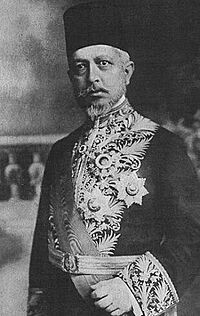Said Halim Pasha facts for kids
Quick facts for kids
Mehmed Said Halim
Pasha
|
|
|---|---|
 |
|
| Grand Vizier of the Ottoman Empire | |
| In office 12 June 1913 – 4 February 1917 |
|
| Monarch | Mehmed V |
| Preceded by | Mahmud Shevket Pasha |
| Succeeded by | Talaat Pasha |
| Personal details | |
| Born | 18 or 28 January 1865 or 19 February 1864 Cairo, Egypt Eyalet, Ottoman Empire |
| Died | 6 December 1921 (aged 56) Rome, Kingdom of Italy |
| Nationality | Ottoman |
| Relations | Muhammad Ali Pasha (grandfather) |
Mehmed Said Halim Pasha (Ottoman Turkish: سعيد حليم پاشا; Turkish: Sait Halim Paşa; 18 or 28 January 1865 or 19 February 1864 – 6 December 1921) was an important leader who served as the Grand Vizier (like a Prime Minister) of the Ottoman Empire from 1913 to 1917. He was involved in some very difficult events during his time in power. He was later killed by Arshavir Shirakian as part of a special operation called Operation Nemesis.
Contents
Early Life and Education
Mehmed Said Halim was born in Cairo, Egypt. His family was very important, as his grandfather was Muhammad Ali Pasha, who founded the Khedivate of Egypt. His family moved to Istanbul in 1870.
He learned many languages from private teachers, including Arabic, Persian, English, and French. Later, he went to Switzerland to study political science. In the 1890s, he married Emine İnci Tosun. A large palace was built for him in Cairo by an Italian architect.
Political Journey
In 1888, Said Halim started his career in government. He became a member of the Council of State, which was an important advisory group. He had a good relationship with Sultan Abdul Hamid II for a while.
However, some people at court spread rumors about him. He then became less involved in his duties. In 1903, he was sent away from the capital because he had connections with a group called the Young Turks. He went to Egypt and then to Europe, where he supported the Young Turks with ideas and money.
Return to Politics
In 1906, Said Halim was given a leading role in the Committee of Progress and Union (CUP), which was a powerful political group. After the 1908 revolution, he returned to Istanbul.
He was appointed to the Ottoman Senate in 1908. He also worked with the Darüşşafaka Society, which was a charity. From January to July 1912, he was the chief of the Council of State. He was sent to Lausanne to help make a peace treaty to end a war, but a change in government meant he had to return home.
Becoming Grand Vizier
After he resigned, he became the General Secretary of the CUP. In 1913, he was appointed to the Council of State again. Soon after, he became the Minister of Foreign Affairs.
On June 12, 1913, he was appointed as the Grand Vizier (Prime Minister). He was chosen because he was a good compromise candidate for the CUP. His family's history was well-respected, and he was seen as someone who could work with different groups.
Time as Grand Vizier
In September 1913, Sultan Mehmed Reşad honored him for his work in signing a peace deal with the Bulgarians. This treaty helped set the border near the Maritsa river, beyond Edirne.
Said Halim Pasha signed the Ottoman–German Alliance in his home. This alliance brought the Ottoman Empire into World War I. He tried to resign after a naval incident, but Sultan Reşad asked him to stay. When Britain took control of Egypt in 1914, Halim Pasha even claimed the throne of Egypt based on an old law.
During his time as Grand Vizier, very sad events happened, including the forced relocation of the Armenian population. The Armenian Patriarch, Zaven I Der Yeghiayan, asked him to stop these actions. Said Halim replied that the reports were exaggerated. The Patriarch himself was later relocated.
Said Halim's time as Grand Vizier ended in 1917 because he had disagreements with the CUP. Mehmed Talaat Pasha took over his position.
Later Life and Death
After World War I, Said Halim was accused of some serious actions during his time in power. He was sent to a prison on Malta in 1919. He was later found not guilty of the accusations and was set free in 1921. He then moved to Sicily.
He wanted to return to Istanbul, but his request was not approved. Soon after, he was killed in Rome by Arshavir Shirakian. This was part of Operation Nemesis, an effort to bring to justice those involved in the difficult events of that time.
Works
- Buhranlarımız ve Son Eserleri
- Buhran-ı İçtimaimiz
- Said Halim Paşa – Bütün Eserleri
See also
- Said Halim government
- Operation Nemesis
- List of Ottoman grand viziers
- Muhammad Ali dynasty
Images for kids


